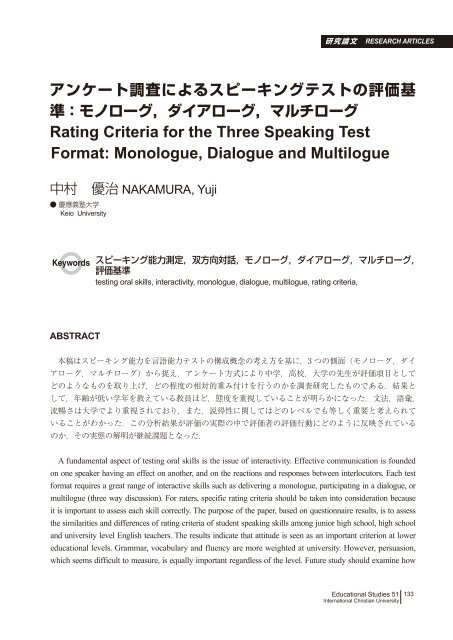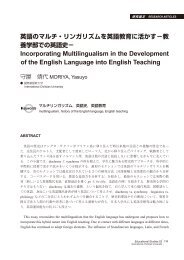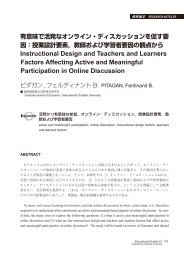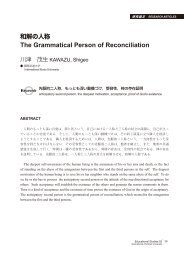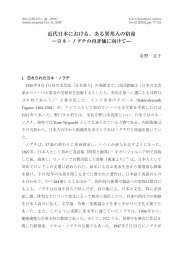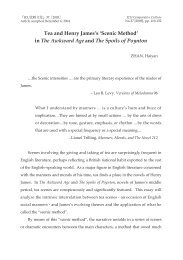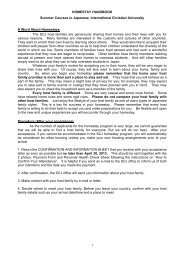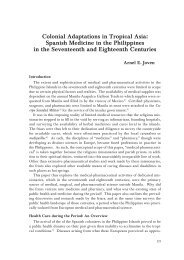Monologue, Dialogue and Multilogue - subsite
Monologue, Dialogue and Multilogue - subsite
Monologue, Dialogue and Multilogue - subsite
Create successful ePaper yourself
Turn your PDF publications into a flip-book with our unique Google optimized e-Paper software.
it less intimidating to hold a discussion withseveral peers rather than with an examiner ina one-on-one interview, to feel having morecontrol over the direction of the conversation,<strong>and</strong> to be allowed to produce more naturallanguage than they otherwise would.3. Purpose of the StudyThe purpose of the paper, based on questionnaireresults, is to assess the similarities <strong>and</strong> differences ofrating criteria of student speaking skills among juniorhigh school, high school <strong>and</strong> university level Englishteachers. It is hoped that a dynamic assessment ofthe oral proficiency from three aspects (<strong>Monologue</strong>,<strong>Dialogue</strong> <strong>and</strong> <strong>Multilogue</strong>) can be explored.4. MethodSubjects (N=)junior high school English teachers (n=)high school English teachers (n=)university English teachers (n=)InstrumentsA questionnaire format (see Appendix).ProceduresSubjects were asked to fill out a questionnaire.AnalysesThe data was analysed using the Excelanalysis program <strong>and</strong> the SPSS statisticalprogram.5. ResultsOverall Tendency<strong>Monologue</strong> Sampling fluency vocabulary grammar attitude organizationnJH .% .% .% .% .%H .% .% .% .% .%UNIV .% .% .% .% .%<strong>Dialogue</strong> Sampling fluency vocabulary grammar attitude comprehensionnJH .% .% .% .% .%H .% .% .% .% .%UNIV .% .% .% .% .%<strong>Multilogue</strong> Sampling fluency vocabulary grammar attitude persuasionnJH .% .% .% .% .%H .% .% .% .% .%UNIV .% .% .% .% .%136Educational Studies 51International Christian University
Table <strong>Monologue</strong> (percentage) <strong>Monologue</strong>a. Fluency fluency, pronunciation, intonation, speed,promptness, pauseb. Vocabularyvocabulary, accuracyc. Grammargrammar, accuracyTable 2<strong>Dialogue</strong> (percentage)d. Attitude attitude, loud/clear voice, eye contact, gesture/body-language, expression, delivery, mood, efforte. Organization organization, coherence, consistency, quantity,length (per sentence), persuasion, memorization,clarity, originality, content, accuracy, emotion, clearconcept of the text, topic, time constrains, bonus <strong>Dialogue</strong>a. Fluency fluency, pronunciation, intonation, speed, natural/quick response, pause, timingb. Vocabularyvocabulary, accuracyc. Grammargrammar, accuracyd. Attitude attitude,loud/clearvoice, eyecontact, activeparticipation, gesture/body-language, cooperation,participation, feeling, expression, delivery,e. Comprehension comprehension, organization, ask <strong>and</strong> answerproperly, appropriateness, persuasion, clarity,engaged listening, quantity, content, accuracy,communication ability, function, clear the task,underst<strong>and</strong>ing the question, discourse competence,dialectic, having cultural background <strong>and</strong> knowledgeEducational Studies 51International Christian University137
Table 3<strong>Multilogue</strong> (percentage) <strong>Multilogue</strong>a. Fluency fluency, pronunciation, intonation, speed, natural/quick response, pause, tone of voice, promptnessb. Vocabularyvocabulary, accuracyc. Grammargrammar, accuracyd. Attitude attitude, leadership, participation, cooperation,loud/clear voice, eye contact, gesture/bodylanguage,aggressive, positive participation, not shy,teamwork, feeling, expression, delivery, number ofturns, plus more answers, playing a required role,making a friendly atmosphere, respecting partners,May I speak?e. Persuasion persuasion, consistency, organization, ask <strong>and</strong>answer properly, appropriateness, logical argument,quantity, content, accuracy, communication ability,function, expressing ideas clearly, task completion,listen to the partner, hearing, underst<strong>and</strong>ingpartner's opinion, say the opinion oneself, havingcultural background <strong>and</strong> knowledge6. Overall Discussion. The lower the educational levels are, the moreimportant attitude becomes. Presumably itis taken for granted that attitude is already aproviso for college students.. In the <strong>Monologue</strong> <strong>and</strong> <strong>Dialogue</strong> skills, Fluencyincluding pronunciation is regarded as importantamong all of the three levels. This is especiallytrue of university teachers. In <strong>Multilogue</strong>,Fluency is rated relatively lower when comparedwith <strong>Monologue</strong> <strong>and</strong> <strong>Dialogue</strong>.. At the university level, Vocabulary <strong>and</strong> Grammarare given twice as much weight compared tojunior <strong>and</strong> senior high schools. Between juniorhigh school <strong>and</strong> senior high school teachers, thelatter insist more on vocabulary <strong>and</strong> grammar.. The last (fifth) category in each skill, i.e.Organization in <strong>Monologue</strong>, Comprehensionin <strong>Dialogue</strong>, Persuasion in <strong>Multilogue</strong>, are themost highly thought of by high school teachers,followed by junior high school <strong>and</strong> universityteachers. Although it is very difficult to establisha clear rating criteria for these three categories(organization, comprehension <strong>and</strong> persuasion),the teachers among all of three education levelscommonly ask for the same three things: ) easycomprehension of the assigned task for students,) competency of speech organization, ) easycomprehension of the counterparts <strong>and</strong> theirappropriate responses to them.138Educational Studies 51International Christian University
7. Conclusions <strong>and</strong> ImplicationsReferencesThe results of the questionnaire in this studydemonstrate a way of looking at the oral skills fromthree tasks (<strong>Monologue</strong>, <strong>Dialogue</strong> <strong>and</strong> <strong>Multilogue</strong>).According to Van Moere (), most of theperformance-based oral testing research literaturehas focused on the traditional face-to-face interviewor simulated (semi-direct) tape mediated interviews.However, the need for language testers to controlthe test situation, elicit ratable language samples inallocated segments of time, or create scenarios toforce particular language functions may have causedthem to overlook opportunities where examineescan be observed producing rich, natural language inconversation with their peers.As Hughes () underlines, a fundamentalaspect of testing oral skills is the issue of interactivity.Good communication is founded on one speakeractually having an effect on another, <strong>and</strong> on thereactions <strong>and</strong> responses which take place betweeninterlocutors. The Certificates in English LanguageSkills (CELS) test format <strong>and</strong> focus for assessmentis an example of a test framework which takes intoaccount far more of the dynamic <strong>and</strong> interpersonalfacets of speech communication (Hughes, ). Thisformat dem<strong>and</strong>s a greater range of interactive skillsto be used (individual speech, dialogue <strong>and</strong> threewaydiscussion) <strong>and</strong> a variety of spoken genres <strong>and</strong>registers to be produced.Although it requires time <strong>and</strong> effort to establish clearrating criteria for different categories in individualtasks, there is also an increased reliability risk of testscores. Therefore, we need to consider the potentialadvantages of group assessments: the benefit of beingable to observe examinees in natural interaction withone another, <strong>and</strong> allowing them to direct <strong>and</strong> controltheir own discourse (cf. Van Moere, ).AcknowledgementI wish to thank Mr. Takanori Yano, a Keio Universitystudent, for his support <strong>and</strong> help in the analysis of this data. Educational Studies 51International Christian University139


